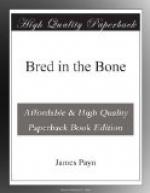One of the arguments that the mothers of those young ladies who sought his hand were wont to make use of, to their great comfort, was that Mr. Carew was a churchman. There was a private chapel at Crompton, the existence of which, of course, explained why his presence did not grace the parish church. Then his genealogy was of the most satisfactory description. Carews had dwelt at Crompton in direct succession for many a century. Charles I., it is almost unnecessary to state, had slept there—that most locomotive of monarchs seems to have honored all old English mansions with a night’s visit—and had hunted in the chase next morning. Queen Elizabeth had also been most graciously pleased to visit her subject, John Carew, on which occasion a wooden tower had been erected for her in the park, from which to see “ten buckes, all having fayre lawe, pulled down with grey-houndes;” she shot deer, too, with her own virgin hands, for which purpose “a cross-bowe was delivered to her by a nymph with a sweet song.” These things, however, were in no way commemorated. Carew was all in all: his devouring egotism swallowed up historical association. His favorite female bull-dog, with her pups, slept in the royal martyr’s apartment. The places in Crompton Chase held remarkable were those where its present owner had made an unprecedentedly long shot, or had beaten off one of the wild cattle without a weapon, or had run down a stag on foot. There was no relic of ancient times preserved whatever, except that at midsummer, as in Lyme, that very curious custom was kept of driving the red deer round the park, and then swimming them through the lake before the house—a very difficult feat, by-the-by, to any save those who have been accustomed to “drive deer.” One peculiar virtue of Carew—he was addressed, by-the-way, by all his inferiors, and some of his equals, as “Squire” only—was, we had almost forgotten to say, his regard for truth, which may truly be said to have been “passionate,” if we consider the effect produced in him when he discovered that any one had told him a falsehood. He would fall upon them tooth and nail, if they were menials; and if guests, he would forbid them his house. This was surely one excellent trait. Yet it was maintained by those carpers already alluded to, that




